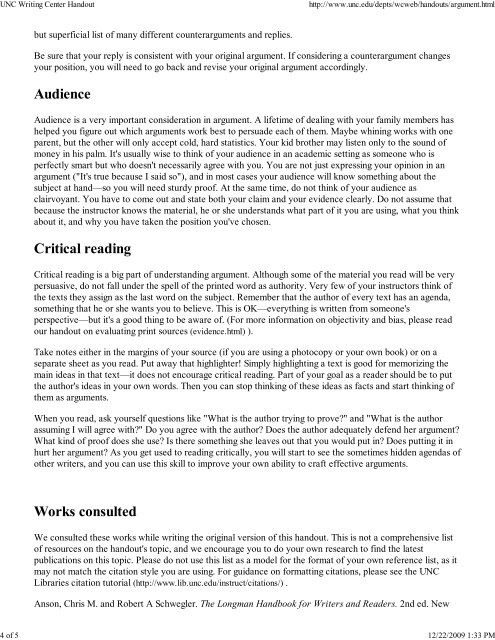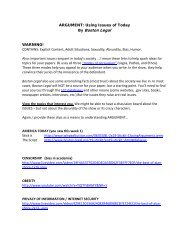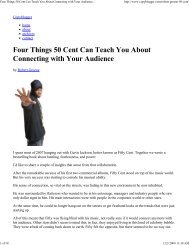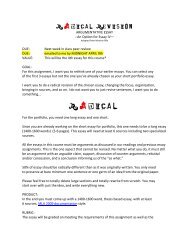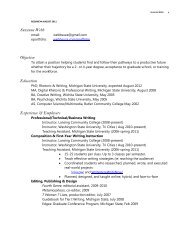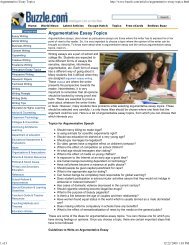UNC Writing Center Handout
UNC Writing Center Handout
UNC Writing Center Handout
You also want an ePaper? Increase the reach of your titles
YUMPU automatically turns print PDFs into web optimized ePapers that Google loves.
<strong>UNC</strong> <strong>Writing</strong> <strong>Center</strong> <strong>Handout</strong>http://www.unc.edu/depts/wcweb/handouts/argument.html4 of 5 12/22/2009 1:33 PMbut superficial list of many different counterarguments and replies.Be sure that your reply is consistent with your original argument. If considering a counterargument changesyour position, you will need to go back and revise your original argument accordingly.Audience is a very important consideration in argument. A lifetime of dealing with your family members hashelped you figure out which arguments work best to persuade each of them. Maybe whining works with oneparent, but the other will only accept cold, hard statistics. Your kid brother may listen only to the sound ofmoney in his palm. It's usually wise to think of your audience in an academic setting as someone who isperfectly smart but who doesn't necessarily agree with you. You are not just expressing your opinion in anargument ("It's true because I said so"), and in most cases your audience will know something about thesubject at hand—so you will need sturdy proof. At the same time, do not think of your audience asclairvoyant. You have to come out and state both your claim and your evidence clearly. Do not assume thatbecause the instructor knows the material, he or she understands what part of it you are using, what you thinkabout it, and why you have taken the position you've chosen.Critical reading is a big part of understanding argument. Although some of the material you read will be verypersuasive, do not fall under the spell of the printed word as authority. Very few of your instructors think ofthe texts they assign as the last word on the subject. Remember that the author of every text has an agenda,something that he or she wants you to believe. This is OK—everything is written from someone'sperspective—but it's a good thing to be aware of. (For more information on objectivity and bias, please readour handout on evaluating print sources (evidence.html) ).Take notes either in the margins of your source (if you are using a photocopy or your own book) or on aseparate sheet as you read. Put away that highlighter! Simply highlighting a text is good for memorizing themain ideas in that text—it does not encourage critical reading. Part of your goal as a reader should be to putthe author's ideas in your own words. Then you can stop thinking of these ideas as facts and start thinking ofthem as arguments.When you read, ask yourself questions like "What is the author trying to prove?" and "What is the authorassuming I will agree with?" Do you agree with the author? Does the author adequately defend her argument?What kind of proof does she use? Is there something she leaves out that you would put in? Does putting it inhurt her argument? As you get used to reading critically, you will start to see the sometimes hidden agendas ofother writers, and you can use this skill to improve your own ability to craft effective arguments.We consulted these works while writing the original version of this handout. This is not a comprehensive listof resources on the handout's topic, and we encourage you to do your own research to find the latestpublications on this topic. Please do not use this list as a model for the format of your own reference list, as itmay not match the citation style you are using. For guidance on formatting citations, please see the <strong>UNC</strong>Libraries citation tutorial (http://www.lib.unc.edu/instruct/citations/) .Anson, Chris M. and Robert A Schwegler. The Longman Handbook for Writers and Readers. 2nd ed. New


